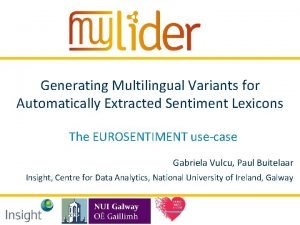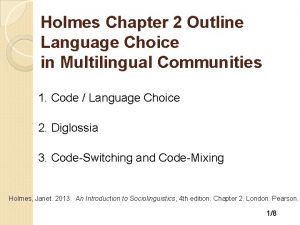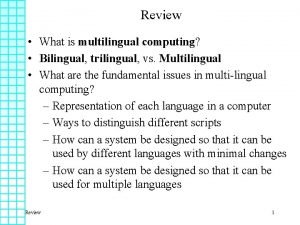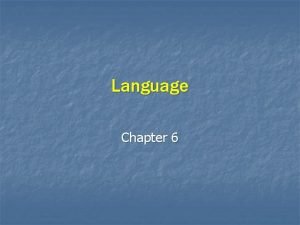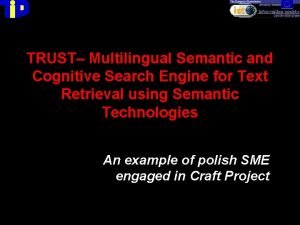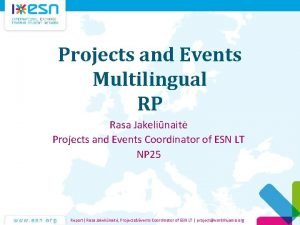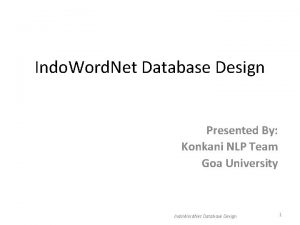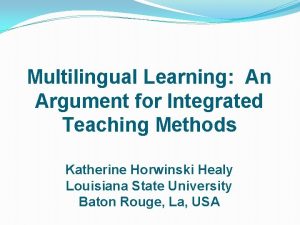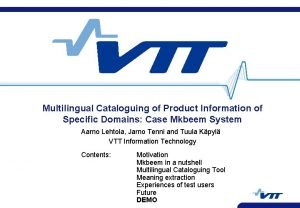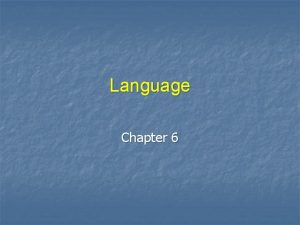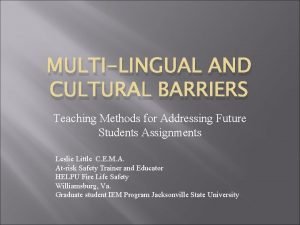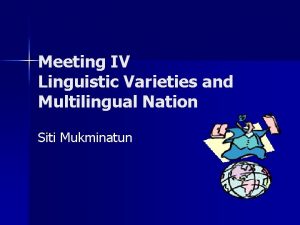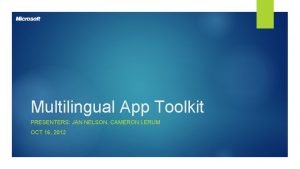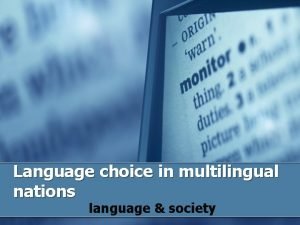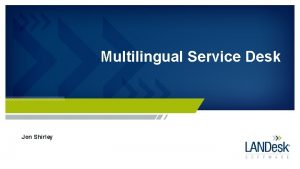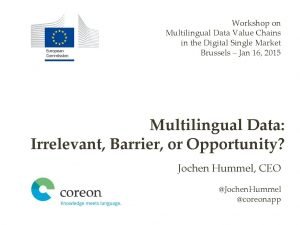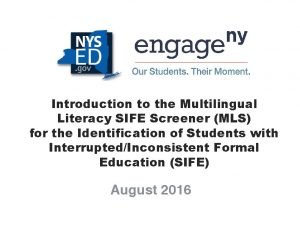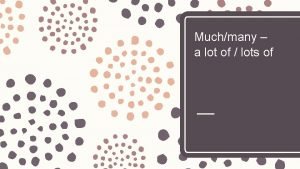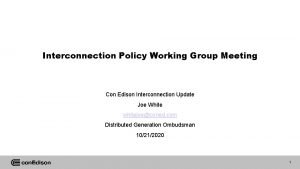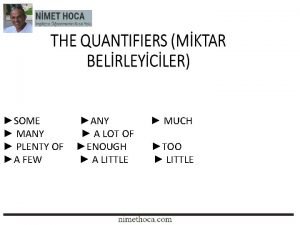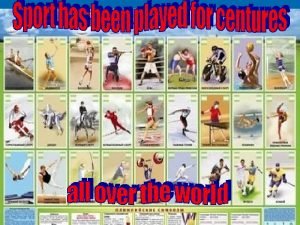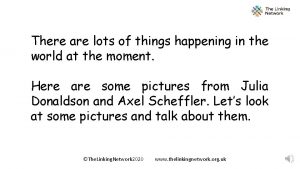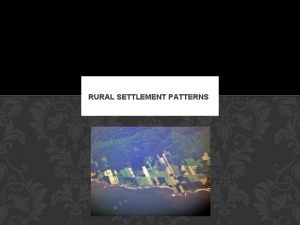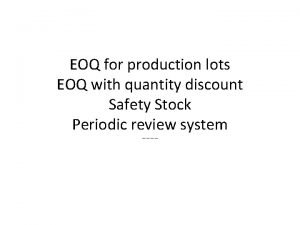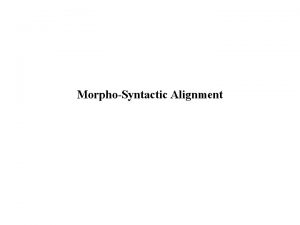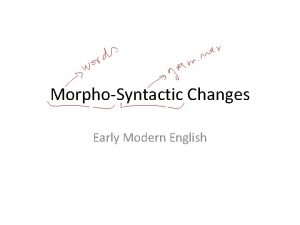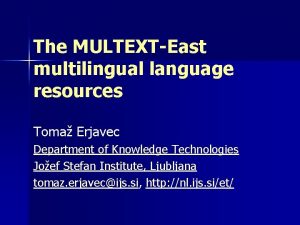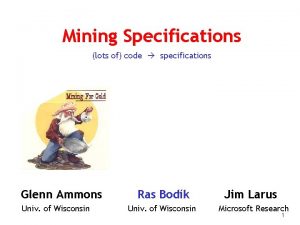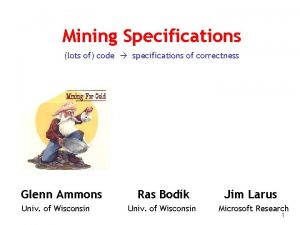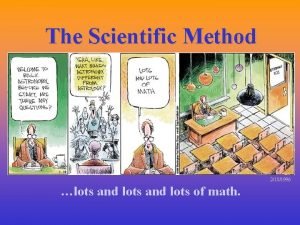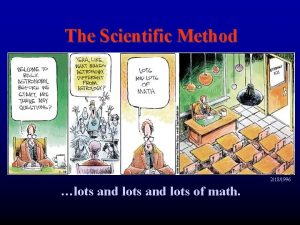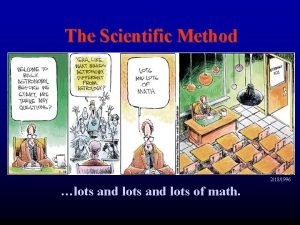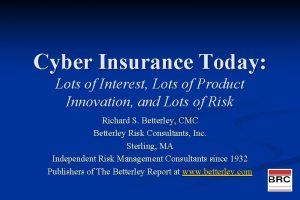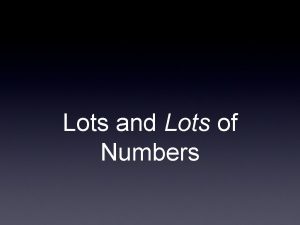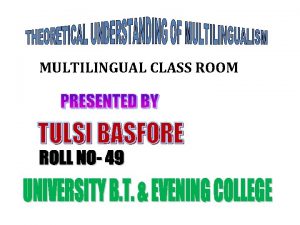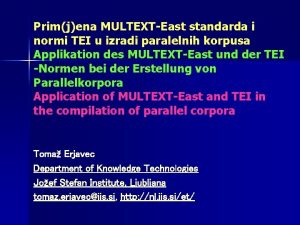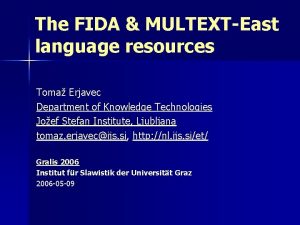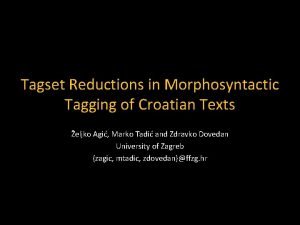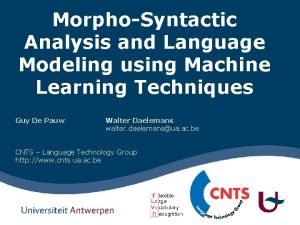MULTEXTEast Version 4 multilingual morphosyntactic specifications for lots

































- Slides: 33

MULTEXT-East Version 4: multilingual morphosyntactic specifications for lots of languages Tomaž Erjavec http: //nl. ijs. si/et/ Department of Knowledge Technologies Jožef Stefan Institute Ljubljana Slovenia Dublin April 3 rd, 2009

Overview of the talk 1. 2. 3. 4. 5. Part-of-speech tagging, tagsets and interoperability MULTEXT(-East) morphosyntactic specifications Languages, formats, transformations An application: JOS resources for Slovene Conclusions Erjavec: MULTEXT-East Version 4 Dublin, 4. 4. 2009

Part-of-speech tagging n n The task of assigning the correct Po. S tag to each word in a running text, e. g. Under/IN the/DT proposal/NN , /, Delmed/NNP would/MD issue/VB about/IN 123. 5/CD million/CD additional/JJ Delmed/NNP common/JJ shares/NNS to/TO Fresenius/NNP … Important HLT infrastructure Very useful annotations for linguists Some applications: u pre-processing step for further analyses: lemmas, syntactic structure, etc. u text indexing, e. g. nouns are more useful than verbs Erjavec: MULTEXT-East Version 4 Dublin, 4. 4. 2009

Methods of Po. S tagging n n Po. S tagging: u determine ambiguity class or word (saw → NN | VBD) u disambiguate to correct tag in (local) context (“I saw/VBD a saw/NN “) Tagger training: u manually annotated corpus: source of probabilities for tags given a (local) context + u (lexicon: gives possible tags for each word-form) Popular taggers: u Tn. T (HMM tagger), Tree. Tagger (decision trees), TBL (transformation based tagging) Tagging usefulness as well as accuracy crucially depends on the tagset Erjavec: MULTEXT-East Version 4 Dublin, 4. 4. 2009

English tagsets n n n Tagging first developed for English (Brown, CLAWS, PTB tagsets) English inflectionally very poor language → small tagsets ~ 50 different tags Tags are typically “synthetic”, i. e. the tag does not transparently map to features e. g. : u to/TO (Po. S? ) u Delmed/NNP (number? ) u shares/NNS (number? ) Erjavec: MULTEXT-East Version 4 Dublin, 4. 4. 2009

Tagsets for other languages n n will often have many more morphosyntactic features associated with a word, so tagsets will be larger e. g. Slovene nouns: u u u type: common, proper gender: masculine, feminine, neuter number: singular, dual, plural case: nom. , gen. , dat. , acc. , loc. , ins. (animacy: yes, no) = 104 “Po. S” tags just for Nouns Russian, Czech, Slovene ~ 1000 -2000 word level syntactict tags u n Erjavec: MULTEXT-East Version 4 Dublin, 4. 4. 2009

Po. S tags vs. MSDs n n n Po. S tags: u used in corpora for corpus annotations / tagging u typically synthetic Morphosyntactic Descriptions (MSDs): u used in inflectional lexica for lexical annotations / morphological analysis u typically analytic Relation of Po. S tagsets to MSD tagsets/features u in general: |Po. S| < |MSD| u but in most MULTEXT-East languages: [Po. S] ≡ [MSD] Erjavec: MULTEXT-East Version 4 Dublin, 4. 4. 2009

Developing a multilingual morphosyntactic framework Interoperability: Tagsets developed for various languages (or even for the same language) have no connection with each other and are often poorly documented n Best practice: Languages that do not yet have a tagset could benefit from an operational framework in which to model it n Erjavec: MULTEXT-East Version 4 Dublin, 4. 4. 2009

so, wouldn’t it be nice to have: an open, standardised, documented, flexible model for MSD/Po. S tagset design, n that would be instantiated for lots of languages, n and could be simply applied to any language? n Erjavec: MULTEXT-East Version 4 Dublin, 4. 4. 2009

EU standardisation efforts n n n EAGLES: Expert Advisory Group for Language Engineering Standards (1993 -1996) MULTEXT: Multilingual Text Tools and Corpora (1995) MULTEXT-East: MULTEXT for Central and Eastern European Languages: u Version 1: TELRI edition (1998) u Version 2: Concede edition (2002) u Version 3: TEI edition (2004) u Version 4: Mondi. Lex edition (2009? ). . . ISO / TC 37 / LMF / iso. Cat (2008) Erjavec: MULTEXT-East Version 4 Dublin, 4. 4. 2009

MULTEXT-East morphosyntactic resources n n Basic Language Resource Kit: 1. specifications: define features and MSDs 2. lexica (~15, 000 lemmas): triplets: word-form / lemma / MSD 3. parallel corpus: MSD and lemma annotated Freely available for research http: //nl. ijs. si/ME/ Erjavec: MULTEXT-East Version 4 Dublin, 4. 4. 2009

1984: aligned annotated Erjavec: MULTEXT-East Version 4 Dublin, 4. 4. 2009

MULTEXT-East languages Erjavec: MULTEXT-East Version 4 Dublin, 4. 4. 2009

The MULTEX(-East) morphosyntactic specifications n n They specify that e. g. ”Ncmsn” u corresponds to the feature-structure [Noun, Type=common, Gender=masculine, Number=singular, Case=nominative] u is a valid MSD for Slovene Specifications consist of u Front matter u Common part - common definitions for all languages (features) u Language particular parts - particulars for each language (MSD set) Erjavec: MULTEXT-East Version 4 Dublin, 4. 4. 2009

V 4 specs draft in HTML Erjavec: MULTEXT-East Version 4 Dublin, 4. 4. 2009

Specifications in Version 4 n n Encoded in XML / tei. Lite (in Version 3: La. Te. X) TEI = Text Encoding Initiative Guidelines P 4 Still in “book-like” in form, to make authoring easier XSLT into other formats: u HTML u tabular mapping formats (e. g. MSD to features) u XML/TEI feature library u (OWL) Erjavec: MULTEXT-East Version 4 Dublin, 4. 4. 2009

The common specifications n n Define categories (“parts-of-speech”) For each category define features, i. e. attributes and their values For each attribute-value specify for which languages it is appropriate Give positional mapping to MSDs: u each attribute assigned a position u each attribute-value assigned a onecharacter code Erjavec: MULTEXT-East Version 4 Dublin, 4. 4. 2009

Common table (HTML) Erjavec: MULTEXT-East Version 4 Dublin, 4. 4. 2009

Common table (source XML/tei. Lite) Erjavec: MULTEXT-East Version 4 Dublin, 4. 4. 2009

Language particular sections Recap the feature definitions for the language n Add “combinations”, i. e. feature-coocurrence restrictions n Add “lexicon”, i. e. list of all valid MSDs for language n Possibly localise the features and codes n Possibly give notes and examples n Erjavec: MULTEXT-East Version 4 Dublin, 4. 4. 2009

Combinations Erjavec: MULTEXT-East Version 4 Dublin, 4. 4. 2009

Lexicon Erjavec: MULTEXT-East Version 4 Dublin, 4. 4. 2009

Jezikoslovno označevanje slovenščine http: //nl. ijs. si/jos Erjavec: MULTEXT-East Version 4 Dublin, 4. 4. 2009

JOS as a bridge to MULTEXT-East Version 4 Fida. PLUS corpus MTE V 3 slv specifications JOS corpora JOS (slv) specifications MTE V 4 specifications Erjavec: MULTEXT-East Version 4 MTE V 4 (slv) specifications Dublin, 4. 4. 2009

Erjavec: MULTEXT-East Version 4 Dublin, 4. 4. 2009

JOS specifications XML/tei. Lite + XSLT transforms n Allow reordering of attribute positions (Vm-----d → Vmd) n i 18 n / slv+eng: u translation: specifications u localisation: attributes, values, codes u localisation: TEI element names n Erjavec: MULTEXT-East Version 4 Dublin, 4. 4. 2009

Erjavec: MULTEXT-East Version 4 Dublin, 4. 4. 2009

Erjavec: MULTEXT-East Version 4 Dublin, 4. 4. 2009

MSD conversion tables n n Tabular UTF-8 files MSD-slv to -eng MSD to features Collating sequence e. g. 01 N 010100 Somei Ncmsn 01 N 0101010200 Somer Ncmsg 01 N 0101010300 Somed Ncmsn Noun Type=common Gender=masculine Number=singular Case=nominative Animacy=0 Ncmsg Noun Type=common Gender=masculine Number=singular Case=genitive Animacy=0 Ncmsd Noun Type=common Gender=masculine Number=singular Case=dative Animacy=0 Erjavec: MULTEXT-East Version 4 Dublin, 4. 4. 2009

Adding a new language n n XSLT scripts: u mtems-split. xsl: make a template for the language particular section of a new language u mtems-merge: merge a new language particular section to the common tables Maybe shortly to be tested on new Slavic languages in the scope of Mondi. Lex Erjavec: MULTEXT-East Version 4 Dublin, 4. 4. 2009

Critiques It’s just an exercise in encoding anyway n Same is different, different is same n The Procrustean bed of standards n n Policy change: from unification to harmonisation (hippy school) Erjavec: MULTEXT-East Version 4 Dublin, 4. 4. 2009

Conclusions n n Presented work-in-progress on “standardisation” of multilingual morphosyntactic specifications Specifications are a de-facto standard for several languages (Romanian, Slovene, Croatian) Could serve as “hub” encoding for multilingual applications, e. g. MT and as an framework for new languages Erjavec: MULTEXT-East Version 4 Dublin, 4. 4. 2009

Further work n n n Finishing MTE V 4! Distribution: LDC, ELDA Relation to ISO-TC 37 standards: u LMF, iso. CAT Connecting to GOLD ontology Adding new languages: u Slavic completion u Western European: MULTEXT u Japanese: chasen tagset, jp. Wa. C(-L 2) u Irish? ☺ Erjavec: MULTEXT-East Version 4 Dublin, 4. 4. 2009
 Qmazon
Qmazon Chapter 2 language choice in multilingual communities
Chapter 2 language choice in multilingual communities Multilingual computing
Multilingual computing Language
Language Cognitive search engine
Cognitive search engine Linguistic diversity ap human geography definition
Linguistic diversity ap human geography definition Multilingual technical support
Multilingual technical support Rasa multilingual
Rasa multilingual What is code mixing
What is code mixing Multilingual database design
Multilingual database design Multilingual teaching methods
Multilingual teaching methods Multilingual product information
Multilingual product information Multilingual e-learning
Multilingual e-learning Semantic tags seo
Semantic tags seo Pie multilingual services
Pie multilingual services Fertile crescent
Fertile crescent Multilingual teaching methods
Multilingual teaching methods Linguistic varieties and multilingual nations
Linguistic varieties and multilingual nations Multilingual app toolkit
Multilingual app toolkit Multilingual nations
Multilingual nations Multilingual service desk
Multilingual service desk Multilingual
Multilingual Mls screener
Mls screener How much vs how many
How much vs how many A lot of / lots of
A lot of / lots of With lots of imagination and new ideas
With lots of imagination and new ideas Biog lots
Biog lots A few ve a little farkı
A few ve a little farkı Kinds of sports
Kinds of sports E lots
E lots I wish you all the strength
I wish you all the strength Picture with lots of things happening
Picture with lots of things happening Concession system of southern ontario
Concession system of southern ontario Eoq with quantity discount
Eoq with quantity discount
